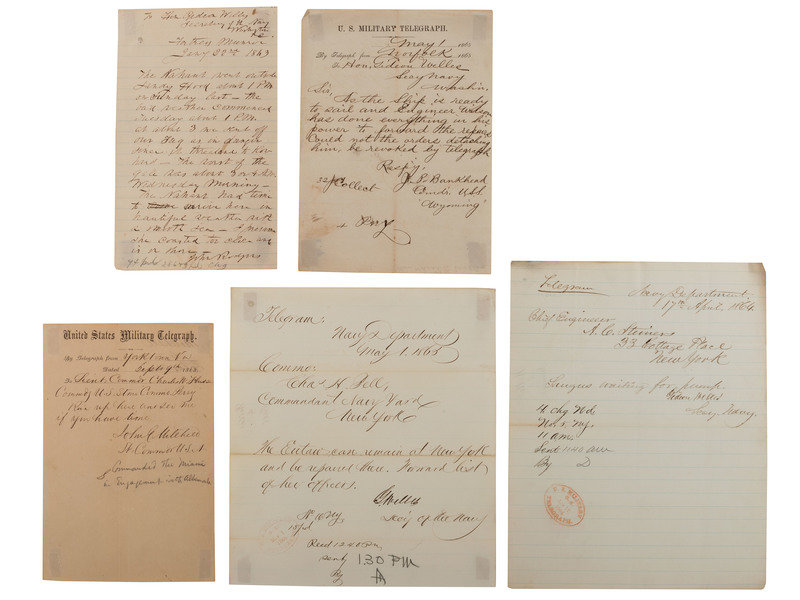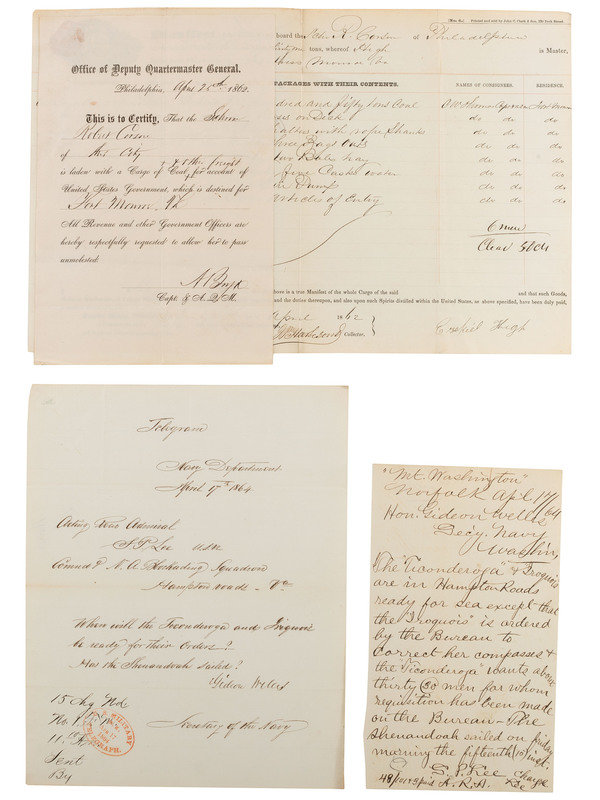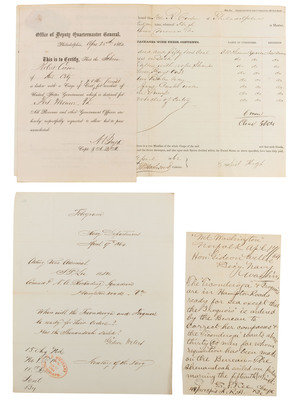Lot 456
[CIVIL WAR - NAVY]. A group of 8 documents related to ships of the Atlantic Blockading Squadron, including letters from Secretary of Navy Gideon Welles and Captain John Rodgers.
Sale 1005 - American Historical Ephemera & Photography
Lots Open
Mar 1, 2022
Lots Close
Mar 8, 2022
Timed Online / Cincinnati
Own a similar item?
Estimate
$500 -
700
Price Realized
$438
Sold prices are inclusive of Buyer’s Premium
Lot Description
[CIVIL WAR - NAVY]. A group of 8 documents related to ships of the Atlantic Blockading Squadron, including letters from Secretary of Navy Gideon Welles and Captain John Rodgers.
RODGERS, John (1812-1882). Autograph letter signed ("John Rodgers"), to Gideon Welles. Fortress Monroe, 22 January 1863. 1 p, 8vo (puncture hole top left corner, adhesive residue on verso). Rodgers reports on the progress of the Nahant: “The Nahant went outside Sandy Hook about 1 p.m. on Sunday last—the bad weather commenced Tuesday about 1 p.m. About 3 we went off our tug as in danger since it threatened to blow hard. The worst of the gale was about 3 or 4 a.m. Wednesday morning. The Nahant had time to arrive here in beautiful weather with a smooth sea. I presume she coasted too close and is on there[?].” In March the Nahant participated in Dupont’s disastrous attack on Charleston Harbor, where she was hit 36 times and badly damaged. On June 17, the Weehawken under Rodgers and the Nahant engaged the formidable Confederate ram Atlanta, which they effectively bombarded as it ran aground, forcing its surrender.
WELLES, Gideon (1802-1878). Letter signed ("Gideon Welles"), as Secretary of the Navy, to Acting Rear Admiral Samuel P. Lee, Commanding North Atlantic Blockading Squadron. Navy Department (Washington, D.C.), 17 April 1864. Marked “Telegram,” 1 p., 4to (puncture hole top left corner, adhesive residue on verso). Welles inquires: “When will the Ticonderoga and Iroquois be ready for their orders. Has the Shenandoah sailed?” At the foot: telegraphic notations and the stamp of the U. S. Military Telegraph, Apr 17 1864. Accompanied by reply from Lee to Welles, letter signed ("S.P. Lee"), 17 April [1864], 1p, 8vo, from Norfolk: “The ‘Ticonderoga & ‘Iroquois” are in Hampton Roads ready for sea except that the ‘Iroquois’ is ordered by the Bureau to correct her compasses & the ‘Ticonderoga’ wants about thirty (30) men for whom requisition has been made on the Bureau. The Shenandoah sailed on Friday morning the fifteenth (15) inst.”
[With:] Two additional letters signed by Welles, both texts of a telegram. The first dated 17 April 1864, to Chief Engineer A. C. Steiner in New York: “Saugus waiting for pump.” The USS Saugus was completed in the month of this letter and assigned to the James River Flotilla of the North Atlantic Blockading Squadron. Though she spent most of her time on the James River, she participated in both attacks on Fort Fisher. The second letter, dated 1 May 1865[?], to Charles H. Bell, Commandant of the New York Navy Yard: “The Eutaw can remain at New York and be repaired there. Forward list of her officers.”
[Also with:] Certificate of the Quartermaster, 25 April 1862, to the effect that the Schooner Robert Corson is “loaded with coal and other freight for account of the United States Government, which is destined for Fort Monroe, Va.” On the printed form of the “Office of Deputy Quartermaster General.” Philadelphia. Accompanied by the cargo manifest. The Schooner Robert Cordon was a commercial ship apparently leased to the Union during the war. After the sinking of the vessel, the owners, including the eponymous Robert Corson, John Allen, Aaron Fries, and John Ericcson, petitioned the Government in 1872 “for the passage of an Act awarding Compensation . . . for the loss of said schooner while in possession of the United States and under direction of its officers, and for freight and demurrage.” [The Congressional Globe (1 March 1872), p. 1314.] The petition succeeded. -- MITCHELL, John E.[?], Lt. Comm. Autograph letter signed, text of a telegram, on stationery of “United States Military Telegraph,” from Yorktown, VA, 9 September 1863, to Lt. Comm. Charles L. Flusser, Comm. US Steamer Commodore Perry, asking Flusser to see him if he has time. Flusser was killed in action on April 19, 1864, during the Battle of Plymouth, commanding the Union naval forces present. --
BANKHEAD, J.[ohn] P.[yne]. Letter signed, 1 May 1865, from Norfolk on board the Wyoming, to Gideon Welles, asking if Engineer Wilson can be detached from his current detail in order to return to the ship, which is ready to depart.
The Richard B. Cohen Civil War Collection
Condition Report
Contact Information
Auction Specialist



